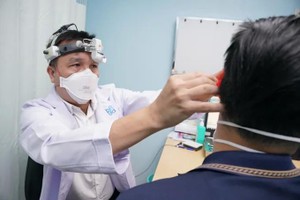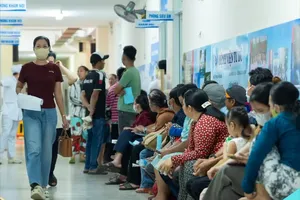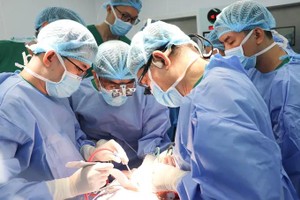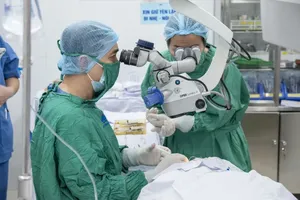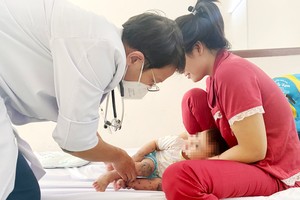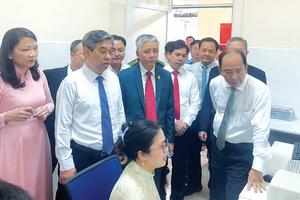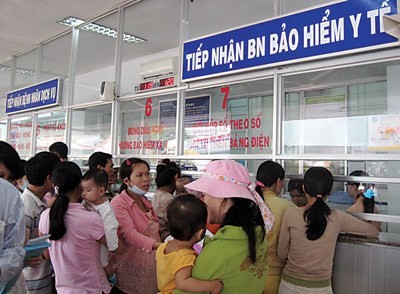
Preparing for questions at the National Assembly session, the Health Minister said that administrative procedure in infirmaries decreased from 12-14 steps to 4 – 8 steps or it cut 48,5 minutes of waiting for a patient.
The patient overload at hospitals in Ho Chi Minh City has been gradually improved thanks to measures that have been taken at many health facilities.
In 2016, the rate of three patients staying in one bed accounted for 4.4 percent in hospitals in provinces, 7.3 percent in districts and 1.5 percent in private hospitals while generally it was 47 percent in hospitals in provinces in 2012.
In 2016, the rate of three patients staying in one bed accounted for 4.4 percent in hospitals in provinces, 7.3 percent in districts and 1.5 percent in private hospitals while generally it was 47 percent in hospitals in provinces in 2012.
In addition, the rate of transferring from small hospitals to big hospital also reduced by 37. 5 percent.
However, she admitted the patient overload in infirmaries has still existed in big hospitals such as Tumor Hospital, Heart Hospital, Children Hospital and the Trauma and Orthopedics Hospital.
The health sector will adopt nine measures in the project to battle the overload in hospitals including increasing the number of medical clinics and beds, building and expanding more clinics, encouraging social contribution in constructing hospitals and infrastructure.
At present, the medical insurance fund can balance till 2018 yet as per the road map to adjust the treatment charges, medical insurance must change, said the Health Minister.
She asked for support from committees of the National Assembly and the National Assembly so that the government will approve the insurance change by 2019. She proposed that people will pay 6 percent of their salary for medical insurance instead of 4.5 percent like now .
There are two options for insurance change. First option is that the change will 0.3 percent a year and it will gradually increase; for instance, it will be 4.8 percent in 2019, up to 5.1 percent in 2020, 5.4 percent in 2022, 5.7 percent in 2023 and it will be 6 percent in 2024.
The second option is the adjustment will be 0.5 percent a year. It will be 5 percent; 5.5 percent and 6 percent in 2019, 2020 and 2021 respectively.
Additionally, the health leader proposed more investment for the sector from state budget from 2018 as per the National Assembly’s resolution No. 18. Investment must be allocated for preventive medicine, buying insurance cards for locals in islands, for people whose economic condition is close to poverty line and for the national targeted programs.
In the first six months of the year, the Ministry’s hot line received 6,281 calls from patients who made complaints or reflected wrongdoings in the health sector. Hospital managers issued warnings to 185 doctors and nurse who have improper attitude to patients, cut bonus of 68 medical workers, transferred 13 others, removed one from their position, and fired 5 people.
However, she admitted the patient overload in infirmaries has still existed in big hospitals such as Tumor Hospital, Heart Hospital, Children Hospital and the Trauma and Orthopedics Hospital.
The health sector will adopt nine measures in the project to battle the overload in hospitals including increasing the number of medical clinics and beds, building and expanding more clinics, encouraging social contribution in constructing hospitals and infrastructure.
At present, the medical insurance fund can balance till 2018 yet as per the road map to adjust the treatment charges, medical insurance must change, said the Health Minister.
She asked for support from committees of the National Assembly and the National Assembly so that the government will approve the insurance change by 2019. She proposed that people will pay 6 percent of their salary for medical insurance instead of 4.5 percent like now .
There are two options for insurance change. First option is that the change will 0.3 percent a year and it will gradually increase; for instance, it will be 4.8 percent in 2019, up to 5.1 percent in 2020, 5.4 percent in 2022, 5.7 percent in 2023 and it will be 6 percent in 2024.
The second option is the adjustment will be 0.5 percent a year. It will be 5 percent; 5.5 percent and 6 percent in 2019, 2020 and 2021 respectively.
Additionally, the health leader proposed more investment for the sector from state budget from 2018 as per the National Assembly’s resolution No. 18. Investment must be allocated for preventive medicine, buying insurance cards for locals in islands, for people whose economic condition is close to poverty line and for the national targeted programs.
In the first six months of the year, the Ministry’s hot line received 6,281 calls from patients who made complaints or reflected wrongdoings in the health sector. Hospital managers issued warnings to 185 doctors and nurse who have improper attitude to patients, cut bonus of 68 medical workers, transferred 13 others, removed one from their position, and fired 5 people.
Hospitals also issued certificates of merit to 58 staffs after receiving patients’ calls to appraise their good attitude.
Minister Tien said that feedbacks of patients has helped improve satisfaction to medical services and workers. As per a study carried out in 22 hospitals in 2016 showed that most of people were satisfied with medical workers’ attitude.
Minister Tien said that feedbacks of patients has helped improve satisfaction to medical services and workers. As per a study carried out in 22 hospitals in 2016 showed that most of people were satisfied with medical workers’ attitude.
Moreover, as per Findings from the 2016 Provincial Governance and Public Administration Performance Index (PAPI) Report released by UNDP on April 4, 2017 showed positive trends in public medical service delivery.
People rate public hospital higher than previous year. Accordingly, the number of people buying medical insurance increased from 62 percent in 2015 to 73 percent in 2016. Especially, healthcare quality for children gratis is improved. Around 32 percent survey participants said that health care service for children under six was very good, (the rate of them in 2015 is 23 percent)
Ms. Tien said that many medical workers abused high techniques in diagnosing and treating. Besides, it is a huge waste when hospitals refused the test result of other hospitals. Infection in several infirmaries is still high.
People rate public hospital higher than previous year. Accordingly, the number of people buying medical insurance increased from 62 percent in 2015 to 73 percent in 2016. Especially, healthcare quality for children gratis is improved. Around 32 percent survey participants said that health care service for children under six was very good, (the rate of them in 2015 is 23 percent)
Ms. Tien said that many medical workers abused high techniques in diagnosing and treating. Besides, it is a huge waste when hospitals refused the test result of other hospitals. Infection in several infirmaries is still high.
Worse, security orders in hospitals has declined recently. Patients still face difficulties in treating due to complicated procedure.


